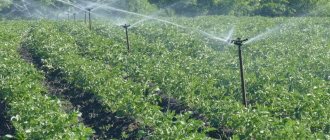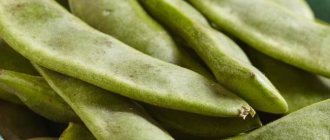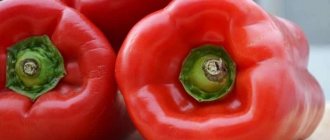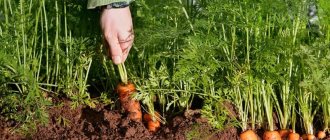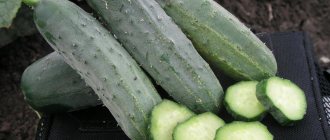The history of the creation of an unusual variety
There is no reliable information about who was the “author” of this variety, therefore the Tsyganochka potato is considered a variety of folk selection.
But there is information about the crossbreeding of which potato varieties produced Gypsy - these are the mid-early Blue Danube potatoes, which were bred by English breeders, as well as the early Baron potatoes bred by Russian breeders.
Photo of Gypsy potatoes
This variety is recommended for cultivation in the center and south of Russia, in Belarus, Moldova and Ukraine.
Tsyganochka potatoes are successfully grown in small farms, as well as in country gardens.
What kind of potato is this?
Gypsy is an old variety of folk selection. It is unknown who exactly brought it out and in what year. This variety has gained popularity in the vast post-Soviet space.
Breeders believe that Gypsy is the product of crossing the Black Prince and the Blue Danube. But many agronomists disagree with this statement.
Some people think that Gypsy and Negritenok are the same variety. This opinion is erroneous, since the latter combines all the potatoes with purple pulp, while the Gypsy has anthocyanin only in the shell, and the inside of the tubers is white.
Distinctive features
The main difference between Gypsy and many other varieties is the unusual appearance of the tubers (with purple skin and white flesh). They are medium in size and oval in shape.
These potatoes are valued for their delicate taste with a rich aroma. The tubers contain an increased content of substances such as iodine, anthocyanin, potassium, magnesium, iron, as well as vitamins B, C, K and PP. Thanks to this, they help cleanse the body of harmful substances and have a positive effect on the condition of the thyroid gland and the body as a whole. The starch content in Tsyganka, on the contrary, is low - about 12%. The variety is recommended for children's and dietary nutrition.
Gypsy also has negative characteristics. This variety is characterized by increased demands on soil composition and watering; it also does not have high resistance to cold weather. The skin of the tubers is very thin, so they are not suitable for long-term transportation.
General characteristics of Gypsy
The Gypsy variety is not considered an unpretentious and hardy potato. Despite this, many vegetable growers continue to grow it because of its excellent taste and rich composition.
Description of the variety:
| Parameter | Index |
| Ground part of the plant | Low, medium-spreading, compact bushes reach a height of 50-70 cm. The leaves are small, dark green, with wavy edges and clearly defined purple veins. The stems are thick, with a purple (anthocyanin) tint. Large, bright blue flowers are collected in small corollas. Berries are rarely produced. The root system is powerful. |
| Tubers | Medium size. The weight of one varies between 100-120 g. The shape is irregular, oval. The potatoes are not wide and uneven, all of different shapes. The peel is thin, bright purple, glossy. There are few ocelli and they are not pigmented; they are distinguished by their superficial occurrence. The pulp is tender, sweetish, with a pronounced potato aroma. It has a cream color, with purple spots on the surface. When cooked it becomes crumbly. Starch content varies between 12-14%. |
| Ripening time | Mid-season. From planting to harvest it takes 70-90 days. |
| Productivity | High. Up to 250 centners are collected from 1 hectare. One bush produces up to 15 tubers. Some of them turn out to be non-marketable - too small. |
| Transportability | Not tall. The thin skin does not allow potatoes to be transported over long distances. The tubers are stored in a cool place all winter. |
| Immunity to disease | Is immune to most nightshade diseases. There is a possibility of late blight infection. |
| Features of cultivation | Recommended for cultivation in the central and southern regions of the country, including Kursk, Moscow, Belgorod, Rostov, and Ryazan regions. |
Main characteristics and description of the blue potato variety Gypsy
Potato Gypsy is early
– from the moment the seed germinates until the ripe tubers are harvested, it usually takes from a little to three months.
The bushes are compact, with erect, strong stems, the color of which is dark blue. The roots of this potato are well developed. The tops are practically not leafy, the leaves are of medium size and have a typical potato shape, their color is dark emerald, the edges are slightly wavy, covered with veins.
The bushes of this potato bloom approximately 32-35 days after planting the tubers in the ground. The flowers are large, bright, blue in color, collected in loose corollas, growing on straight peduncles.
The shape of the tubers is an elongated oval, without ribs or dents. The peel is thin, glossy, smooth, its color is light ink. The number of eyes is small, they are pressed shallowly into the pulp. The weight of the tubers is 110-125 g. The pulp is creamy in color, sometimes with purple specks.
EXCELLENT POTATO VARIETIES!
Aurora Potatoes Granada
Potatoes The pulp of the Gypsy potato contains a lot of protein, almost all vitamins, iodine, some other macro- and microelements, the amount of starch is 12.5-14.5%.
The peel of Gypsy is too thin and delicate, so it is easily damaged during mechanical harvesting, which is one of the disadvantages of the variety when grown on an industrial scale.
Photo of the weight of the Gypsy potato
After harvesting, the tubers should be sorted, putting only intact potatoes into long-term storage - they are stored for up to six months, do not dry out and do not lose their excellent taste.
Harvested tubers do not tolerate long-distance transportation well.
The flesh does not darken when cut; during cooking, the potatoes retain their excellent taste and do not become overcooked. The tubers are used for baking, preparing side dishes, and added to salads.
PURPLE POTATOES, cultivation, yield - video
Main varietal characteristics
With proper agricultural technology, you can grow up to 250 c/ha. Each bush produces from 6 to 14 tubers weighing 90-130 g. The growing season is 70-90 days, which allows this variety to be classified as early or mid-early. What exactly it will be depends on the region of growth and planting time. The starch content in tubers is up to 14%. They also contain a large number of useful micro- and macroelements.
As mentioned above, the marketability of tubers can only be preserved by manual harvesting due to their high susceptibility to mechanical damage. For the same reason, Gypsy potatoes do not tolerate transportation well. Keeping quality also leaves much to be desired; storage losses average 8% of the total weight.
All these disadvantages more than offset the taste. Gypsy's are excellent. Tubers are distinguished by their culinary versatility; they can be used to prepare a wide variety of dishes. The pulp is tender, without wateriness, boils perfectly and delights with a real potato taste and aroma.
It should be noted that the variety is demanding on soils, climatic conditions and care. Regardless of the region of cultivation and the composition of the soil, in any case it must be well fertilized. During dry periods, plants will require abundant watering. Lack of moisture negatively affects the development of tubers, which leads to a significant decrease in yield. In addition to watering, the variety requires timely implementation of other agrotechnical measures.
Characteristics of Gypsy potato yield
One bush can produce both large, medium and small tubers.
Their size and taste are influenced by the following factors:
- soil fertility;
- ambient temperature;
- compliance with the irrigation regime.
Photo of Gypsy potato pulp
But in general, the yield of Tsyganochka potatoes is high:
230-240 centners of ripe tubers are harvested from 1 hectare.
Brief description of the variety
Potato Gypsy can be described as follows:
- compact plant of medium height;
- dark stems with a barely noticeable bluish tint;
- volume of green mass – average;
- leaves are dark green, with pronounced veins and slightly wavy edges;
- inflorescences are large and dense, blue in color;
- berries are almost never formed;
- the root system is well developed.
Due to the compactness of the bushes, these potatoes can be planted in a non-standard pattern - so that the plants are closer to each other. This will prevent weeds from growing and taking nutrients from the crop. But you also can’t plant it too densely, because the tubers also need space.
Diseases and pests
This vegetable crop is highly resistant to a number of diseases characteristic of plants of the Solanaceae family:
- potato cancer;
- common scab;
- gray rot;
- Alternaria;
- fusarium;
- verticillium;
- late blight.
THE BEST POTATO VARIETIES!
Potato Zhuravinka Potato Milena
Of the pests, the Colorado potato beetle poses the greatest danger to this potato variety. It is recommended to treat the tubers before planting against this “harmful” insect, for example, with “Prestige”, and also to carry out preventive spraying of the bushes with appropriate insecticides. Many vegetable growers prefer not to use chemicals to treat potatoes against the Colorado potato beetle, but regularly pick these pests by hand and burn them.
Advantages and disadvantages
The main advantages of the Tsyganochka variety are:
- good taste;
- early ripeness of the variety;
- good yield;
- original coloring of the peel;
- resistance to most diseases characteristic of other potato varieties.
Purple potatoes. Tasting - video
This potato has no serious disadvantages. It is only necessary to note that the Tsyganochka variety shows high yield only on fertile soils and subject to the irrigation regime. Another feature of this potato is that its skin is too thin, which is convenient for cooking, but mechanical harvesting of Tsyganochka tubers is excluded.
Potato Gypsy: planting, growing and care
After harvesting, the tubers are sorted before being stored in the cellar. Separately, potatoes should be selected for further planting. They must be large, not damaged by diseases or “harmful” bugs, and collected only from healthy plants.
Important!
Typically, vegetable growers leave small “non-marketable” potatoes for planting. But large bushes are unlikely to grow from such planting material, and root crops collected from bushes do not grow more than average in size.
Growing early potatoes - video
Preparing seed potatoes for planting
Tubers selected for planting are removed from the cellar for germination approximately 4 weeks before planting them in open ground. They are laid out in a sunny area for greening, and a special poison is formed in the tubers - corned beef, thanks to which these tubers will not be damaged by pests after planting in the soil.
Photo of potato germination
Germinated Tsyganochka tubers should be planted in open ground when the sprouts on them have grown to a length of 1-1.5 cm. If the eyes remain “dormant”, then it is not recommended to plant such planting material - it will germinate much later than the sprouted tubers, the bushes will be weak , and the yield is low.
Before planting, all planting material is pickled, then dried and treated with growth stimulants. All these procedures must be done carefully so as not to damage the sprouts.
Agricultural technology
Planting potatoes is possible when the soil warms up to a temperature of 10˚C at a depth of 15 cm. In the southern regions this happens in early April, and in temperate climates - at the end. This option is not suitable for areas with short summers.
Preparation of planting material
Usually, by spring, potatoes germinate in the cellar on their own. If this does not happen, the process is stimulated artificially:
- The tubers are sorted. Choose a medium size, without stains, damage or traces of infection.
- Potatoes are placed in a place with a temperature of +17°C . They are laid in one row on sawdust or newspaper, and covered with a layer of newspaper or sawdust on top.
- I spray it with warm water every day from a spray bottle . After about two weeks, sprouts should appear.
Sprouted tubers are prepared for planting. This process consists of the following steps:
- The tubers are dipped in a solution prepared from 1 tsp. copper sulfate and 3 liters of water. After this, they are left in a warm place until completely dry.
- The planting material is rinsed with a product prepared from 0.5 tsp. boric acid and 3 liters of water. It is then allowed to dry completely.
- Potatoes are immersed in a solution of 1 tsp. “Mortar” and 3 liters of water. Then lay out in one row until completely dry.
- Two days before planting, the potatoes are taken to a place with a temperature of +10...+12°C.
Planting material treated in this way becomes more resilient and germinates faster. Disinfecting potatoes is the best prevention of diseases.
Important! Small specimens of Gypsy are not suitable for planting. Such planting material causes low yields and degeneration of the variety.
Preparing beds and planting
Potato beds are prepared in advance. A well-lit area of the garden is chosen for them. It is important that groundwater is not close to the surface.
Potatoes are not grown in one place for more than two years. This plant should not be planted after other nightshade crops.
Important! Potatoes are carriers of late blight. This fungus overwinters in its tubers. It is also this plant that attracts the Colorado potato beetle. It is not recommended to plant tomatoes, peppers, or eggplants next to it.
In the fall, the beds are dug up, clearing of plant debris. If the collected grass does not show signs of any diseases, it is useful to bury it to enrich the soil.
Humus or manure is additionally added to the soil at the rate of 6 kg per 1 sq. m. Then the acidity of the soil is measured with litmus paper. If the indicators are increased, for every 1 sq. m bring in a glass of ash.
Related article: Red potato varieties: names, advantages and disadvantages
In the spring, the beds are dug up and cleared of weeds. For each square meter, add 25 g of superphosphate and 15 g of urea. The beds are leveled with a rake and watered with hot copper sulfate: 1 tbsp. l of powder per 10 l of water.
The holes are dug to a depth of 6-10 cm. They are placed in rows in a checkerboard pattern, using a pattern of 35 cm between holes in a row and 70-100 cm between rows. A large distance provides a sufficient amount of soil for hilling.
A handful of ash is poured into the holes. Then they throw one tuber there and sprinkle it with soil without compacting it. Plantings are watered abundantly with warm water. Some gardeners cover the beds with film before the first shoots appear.
Basic rules of care
To get a bountiful harvest of high-quality potatoes, the plants are provided with regular and proper care. For Gypsy, compliance with the rules of agricultural technology is especially important, since this variety is whimsical:
- Before the first shoots appear, the soil is regularly loosened. This is done with a rake, removing weeds in the process.
- Potatoes are watered on average three times per season: before, during and after flowering. This is done generously to moisten the soil to a depth of 50 cm. Up to 4 liters of water are poured under each bush. If the summer is hot and dry, two more waterings are done per season. Water the potatoes early in the morning or after sunset so that the liquid does not get on the leaves.
- After each watering and rainfall, the soil must be loosened. This is done carefully so as not to damage the tubers. The process removes weeds.
- Potatoes are hilled at least twice a season. The first - when the plant reaches a height of 15 cm, and the second - after three weeks. To do this, the soil from the rows is raked to the stems to a height of at least 6 cm. This procedure helps to increase the yield at least twice.
- Experienced gardeners recommend mulching potato beds with hay or straw. This layer slows down the development of weeds, protects plants from cold weather, diseases, pests and allows you to loosen the soil much less often.
- Gypsy is demanding when it comes to feeding. They are applied at least three times per season. The first time fertilizer is applied two weeks after emergence: mullein or a solution of chicken manure is diluted 10:10 with water. After the formation of the first bud, apply a second fertilizer prepared from one bucket of water and 1 tbsp. ash. During the period of mass formation of inflorescences, potatoes are fed for the last time. To do this, take 25 g of superphosphate per bucket of chicken manure solution. Fertilizers are applied after abundant watering of plants.
- Ten days before harvest, potato bushes are sprayed with superphosphate. This foliar feeding allows you to obtain the maximum number of marketable tubers.
An unusual way of growing, or potatoes in a bag
For those who do not have a lot of space on their plot, an interesting method of growing potatoes in bags is suitable. This method not only allows you to get an impressive harvest with minimal space, but also makes caring for the crop much easier.
For planting, use any thick bags: special bags, cereal bags, sugar bags, flour bags, or garbage bags. They are placed near a support - a wall or one built independently from bricks.
The soil for potatoes is prepared from equal parts of garden soil and compost. The soil must be disinfected.
30 cm of soil is poured into the bottom of the bag. 3-4 tubers prepared in the usual way are placed in each bag. They are sprinkled with a 15-20 cm layer of earth on top and watered with warm water.
When the plants reach a height of 10 cm, add enough soil to the bags so that only 2-3 leaves remain above the surface. During the season, this hilling is repeated two more times so that the bag is two-thirds full.
The soil in the bags is moistened as it dries. Drying out the soil will lead to the death of plants.
During the entire growing period, fertilizing is applied only once. Use fertilizers containing calcium and phosphorus.
Diseases and pests
Gypsy is immune to almost all potato diseases. The exception is late blight. The variety has average resistance to it. To avoid infection with this fungus, all materials and garden tools are disinfected, and the rules of watering and crop rotation are followed. As an additional preventive measure, the beds are sprayed with a solution of copper sulfate.
The Colorado potato beetle poses a danger to Gypsy. To protect plantings from it, use the following methods:
- Traps. Two weeks before planting potatoes, several potato bushes are planted near the site (small planting material is allowed). By the time of planting, the potatoes will grow and attract pests. The bushes are removed and burned along with the beetles.
- Collection of insects. The Colorado potato beetle and its larvae are collected by hand.
- Plants between rows . Calendula and beans planted between rows repel pests.
- Ash. The beds are sprinkled with ash after each watering.
- Chemicals . Plants are sprayed with special preparations, for example, “Barrier”.
It is more difficult to protect plantings from mole crickets and wireworms. Removing the larvae during autumn and autumn digging, following the rules of prevention and watering the soil with boiling water before planting will help.
Preparing the site for planting
The area for planting potatoes has been prepared since the fall. After harvesting from the garden, all plant residues should be removed along with the roots; at least 6 kg of rotted manure or compost should be added to each square of area for digging.
In the spring the area is dug up again. The best soils for planting potatoes are sandy or loamy.
The soil should have a neutral reaction, be loose and fertile.
The area should be well illuminated by sunlight and protected from gusts of cold winds. You should not prepare beds for potatoes in lowlands or highlands, in swampy areas or where groundwater comes too close to the soil surface.
When growing any vegetable crops in garden beds, do not forget about the basic rules of crop rotation. When choosing a place for planting, you should remember that potatoes are grown in the same place once every 3-4 seasons. Also, you should not plant this vegetable crop after any cultivated plants from the Solanaceae family, since they are damaged by the same pests and pathogenic microorganisms that can accumulate in the soil.
Landing
Tubers for germination are brought into warm verandas and sheds 21-30 days before the planned planting. Seed material of the middle fraction is selected - 5 by 7 cm, weighing from 40 to 80 g. The potatoes are reviewed and left without damage, stains, or growths.
Sprout in the classic way on the floor, in boxes. You can quickly germinate tubers in a moist substrate - peat, humus. This method is economical and fast.
Loose soils, sandy loam, turf, and loamy soils with a medium granulometric fraction are suitable for cultivation. Fertilizers are applied during autumn plowing and directly into the holes. Optimal pH is within 5.2-6. Observe crop rotation, plant purple potatoes after the following types:
- peas, beans;
- green manure (lupine, mustard, oats);
- roots;
- cruciferous vegetables.
The variety is planted in even rows - this is a classic option. Gypsy does not like close proximity to groundwater (above 1 m to the surface); in this case, planting is done in ridges. Potatoes are planted on the beds in increments of 25-30 cm, the distance between the beds is 65-70 cm.
Planting Gypsy potatoes in open ground
Planting holes are dug at a distance of 0.35-0.4 m from each other, and the distance between rows is 0.65-0.75 m.
Photo of planting potatoes in open ground
The depth of the holes should be no more than 10 cm. A layer of humus, wood ash and a little onion or garlic peel are laid on their bottom (to repel pests and their larvae, in particular wireworms).
After planting, the potato beds are watered.
[/banner_n6
Further care for the Gypsy potato variety
Further care for Tsyganochka potatoes includes dosed watering, loosening the soil, and hilling.
Potatoes should be watered sparingly so that moisture does not stagnate in the soil. During rainy seasons, watering is reduced. Moisture is added to potato beds only before flowering, then these vegetable plants practically do not require water.
After each watering, it is necessary to loosen the soil and remove all weeds at the same time.
This variety requires hilling at least twice per season. The first time the hilling procedure is carried out when the sprouts reach a height of 8-10 cm. The next hilling is carried out approximately 2.5-3 weeks after the first, forming ridges about 20 cm high.
Care
Hilling
During the growth of potatoes, they are hilled twice to form high ridges:
- The first time this is done after the emergence of seedlings.
- The second time is before flowering.
Watering
The variety is not drought resistant. Therefore, to obtain a good harvest, potatoes must be provided with sufficient moisture. Watering is done every 7-10 days. Before hilling, the bushes are watered by drip. When hilling, grooves are formed between the furrows, into which water is then poured.
Loosening
Loosening allows you to retain moisture in the soil longer and ensure access of sufficient oxygen to the tubers. It is best to loosen the soil every time after rains and heavy watering.
Weeding
If necessary, the crop should be weeded . The removed weeds are taken to the compost pit. It is not recommended to leave them in the beds to avoid infecting the potatoes with various diseases.
Top dressing
I usually recommend feeding potatoes three times a season.
- During the active growing season , when the shoots are still weak. You can use this recipe: mix 15 cups of humus and 10 tsp. urea. Distribute this amount over 10 m of planting.
- At the beginning of flowering . You can use 30 tbsp. l. ash and 10 tsp. potassium sulfate per 10 linear meters of crop.
- During the period of tuber formation, it is very good to prepare the following fertilizing composition: 2 tbsp. l. superphosphate +2 tbsp. l. potassium sulfate + 1 tbsp. l. nitrophoska for 10 l. water. The fertilizer rate is 0.5 liters for each bush.
Other care measures
To achieve a good harvest, you can use a secret with a 137-year history. R.I. Schroeder suggested breaking the stems at a height of about 10 cm from the ground two weeks after the start of flowering. The stem must be broken in such a way that it cannot rise, but in general it does not lose its integrity.
Schroeder believed that the juices going into the stem would reach the break point and return back to the tubers, stimulating their development and growth.
How to properly feed potatoes
Typically, all the necessary nutrients are added to the garden beds before the potatoes are planted. And only if necessary, once a season you can feed the bushes of this vegetable crop with complex mineral fertilizer.
Photo of fertilizing before planting potatoes
Features of cultivation
As for agricultural technology, the largest tubers that are not damaged by pests, collected from large, healthy bushes, are selected . Planting small items that are not marketable greatly reduces the yield, and the potatoes may degenerate.
Before planting, the tubers are pickled, dried, and treated with growth stimulants. After this, they are laid out in the light to germinate. The sprouts appear together, making it possible to plant not whole tubers, but segments with eyes . Root crops are cut with a disinfected knife immediately before planting.
The soil for potatoes should warm up well. The ideal temperature is from 12 degrees. The soil is thoroughly loosened, removing plant remains, and humus and wood ash are laid out in the holes. The bushes are placed at a distance of 30-35 cm, leaving row spacing of 70 cm.
During cultivation, potatoes are hilled at least 2 times, forming high ridges . Dosed watering is useful; it significantly improves productivity. It is possible to fertilize with a mineral complex or organic matter, but no more than once per season.
Read more about what to feed potatoes, when and how to apply fertilizers, and how to do it correctly when planting.
Mulching can be used to control weeds.
A week before the start of harvesting, it is recommended to cut off all the tops; this will allow the tubers to gain weight and also accumulate useful substances. You should not allow potatoes to lie in the ground; it is better to remove them a little earlier. This approach will help avoid diseases (for example, late blight).
Reviews of Gypsy potatoes
Natalya, 45 years old, Krasnodar region: My husband and I have been growing potatoes for further sale for decades. During this time, we tried many early potato varieties. In recent years, we have been successfully growing the Tsyganochka variety, among others. We liked the variety for its unusual peel color, good taste of the pulp, good yield, and good keeping quality.
Mikhail, 50 years old, Volzhsky: I have been planting Gypsy potatoes for several seasons now. It does not require special care and lies well in the cellar for up to six months. But the tubers have a thin skin, so you should dig it up carefully, because damaged root crops cannot be stored - they quickly begin to rot. Also, the tops are often attacked by the Colorado potato beetle, which has to be fought during the entire period of growing potatoes.
This productive potato variety is popular not only among Russian vegetable growers, but also in Ukraine and Belarus.
Unpretentiousness to growing conditions, good taste of tubers, resistance to most diseases characteristic of other potato varieties are the main reasons for such popularity.
Harvest and storage
Gypsy is ready for harvest in mid-August. The fact that the tubers need to be dug up is indicated by yellowing and wilting of the above-ground parts of the plants.
The tubers have a thin skin, so they are collected only by hand and then sorted. Small and large specimens are stored separately.
Potatoes are stored in the basement, cellar or on the balcony in insulated boxes. Before this, it is dried in a well-ventilated place and cleaned of soil with a dry cloth. Damaged copies cannot be stored.
Gypsy is used to prepare dishes that involve boiling, stewing and baking. This variety is not suitable for frying, since due to its low starch content it does not form a golden brown crust.

